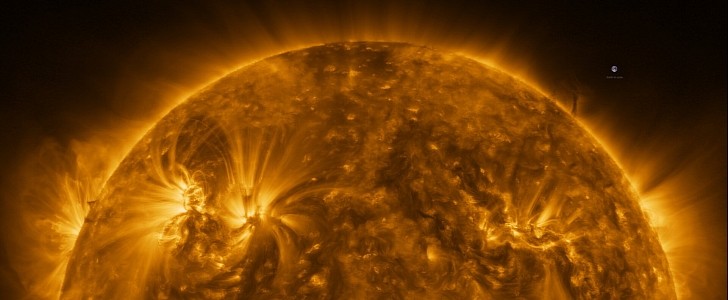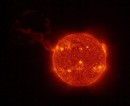The European Space Agency (ESA) Solar Orbiter spacecraft has recently snapped an incredible photo of the Sun – it's the highest-resolution image of our star ever taken. The picture was shot at a distance of roughly 46 million miles (75 million km) away, and it shows the Sun's scorching atmosphere in unprecedented detail.
Using the Extreme Ultraviolet Imager (EUI), one of its remote sensing instruments onboard, the Solar Orbiter probe took an insanely detailed image of the Sun's outer atmosphere, the corona. The photo was taken on March 7th, when the spacecraft was at a distance of 46 million miles (75 million km) away from the star. That's around halfway between our planet and the Sun.
And since the Solar Orbiter was so close to this giant fireball, its EUI had to snap 25 individual images to cover the Sun. They were all stitched together to form this stunning, high-resolution photo. ESA says that the final image has "more than 83 million pixels in a 9148 x 9112 pixel grid." That's a resolution ten times higher than what we see on a 4K TV screen.
This significant milestone will help scientists better understand the magnetic activity of the Sun. In the recent high-res image taken by the probe, there are dark filaments that seem to extend from the star's surface. These "prominences," as the agency calls them, can erupt and send harmful electromagnetic radiation into space that can affect Earth's satellites.
More detailed images are expected to follow as the Solar Orbiter gets closer to the Sun. Tomorrow, on March 26th, it will be less than one-third of the distance from the star to our planet, and it will use all ten instruments on board at the same time to collect as much data as it can. But don't expect to see pictures the next day – it will take a while for the data to get sent back to Earth.
The probe will continue to travel close to the Sun in the next few years, and it will change its orientation to observe the star's poles, which are regions that have never been studied before.
And since the Solar Orbiter was so close to this giant fireball, its EUI had to snap 25 individual images to cover the Sun. They were all stitched together to form this stunning, high-resolution photo. ESA says that the final image has "more than 83 million pixels in a 9148 x 9112 pixel grid." That's a resolution ten times higher than what we see on a 4K TV screen.
This significant milestone will help scientists better understand the magnetic activity of the Sun. In the recent high-res image taken by the probe, there are dark filaments that seem to extend from the star's surface. These "prominences," as the agency calls them, can erupt and send harmful electromagnetic radiation into space that can affect Earth's satellites.
More detailed images are expected to follow as the Solar Orbiter gets closer to the Sun. Tomorrow, on March 26th, it will be less than one-third of the distance from the star to our planet, and it will use all ten instruments on board at the same time to collect as much data as it can. But don't expect to see pictures the next day – it will take a while for the data to get sent back to Earth.
The probe will continue to travel close to the Sun in the next few years, and it will change its orientation to observe the star's poles, which are regions that have never been studied before.







